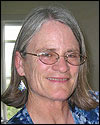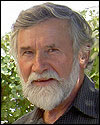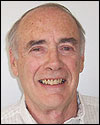GSA Medals & Awards
2007
Kirk Bryan Award
[ view response ]
All 2007
Division Award Recipients
|
Presented to Marith Cady Reheis, Andrei M. Sarna-Wojcicki, Richard L. Reynolds, Charles A. Repenning, and Martin D. Mifflin
for Reheis, M.C., Sarna-Wojcicki, A.M., Reynolds, R.L., Repenning, C.A., and Mifflin, M.D., 2002, Pliocene to middle Pleistocene lakes in the western Great Basin-Ages and connections, in Hershler, R., Currey, D., and Madsen, D., eds., Great Basin Aquatic Systems History: Smithsonian Contributions to Earth Sciences no. 33: Washington, D.C., Smithsonian Institution Press, p. 53-108. |

Marith Cady Reheis
USGS Denver
|

Andrei M.
Sarna-Wojcicki
USGS
|

Richard L. Reynolds
USGS
|

Martin D. Mifflin
Mifflin and Associates
|
|
| |
Not Pictured: Charles A. Repenning, USGS (deceased) |
|
|
Citation by Fred M. Phillips
It is my great pleasure today to introduce Marith Reheis and her coauthors Andrei Sarna-Wojcicki, Rich Reynolds, Chuck Repenning, and Marty Mifflin as the recipients of the 2007 Kirk Bryan Award for Research Excellence. The award recognizes their contribution to Quaternary geology through the publication of the paper “Pliocene to middle Pleistocene lakes in the western Great Basin—Ages and connections”, which appeared in 2002 in the monograph “Smithsonian Contributions to Earth Sciences Number 33”.
The dramatic evidence of huge lakes in a now-desert environment attracted the attention of the first geologists to visit the Great Basin. The earliest major studies of Quaternary geology in the Great Basin, in the 1870s and 1880s by Russell and Gilbert, focused on the evidence for these lakes and its interpretation. These were the seminal works that provided the key to understanding the late Quaternary paleoclimatic and geomorphic histories of the Great Basin.
One curious fact that these early investigators established was that there was clear geomorphic evidence for only one major lake cycle—i.e., that there is a single highstand shoreline of relatively young age, and little or no evidence of older shorelines. Both Russell and Gilbert inferred, based on stratigraphic evidence, that there had been at least one earlier lake cycle, but this still left open a tantalizing question: why was the most recent pluvial episode the greatest of all time?
This conundrum was further complicated by aquatic biogeography studies pioneered by Carl Hubbs and Robert Miller in the mid-20th century. They and subsequent investigators showed that the hydrographic interconnections provided by the Last Glacial Maximum highstand were not capable of explaining the observed distribution of fish species in the Great Basin.
A key piece in solving these puzzles has now been provided by Marith Reheis and her coauthors in the paper cited above. A few previous workers had noted very scanty evidence of shorelines higher than the LGM highstand. These were mostly dismissed as “anomalous”. Marith, however, seized on these hints and examined numerous targeted localities across the western Great Basin. At many of these she did indeed find evidence of very old, very high lake stands. At many sites this evidence consists of wave-rounded pebbles on geomorphic benches, but at others it was corroborated by detailed stratigraphic work. Although such evidence at a single site might be considered equivocal, the overwhelming mass and consistency of the data presented in this paper is persuasive.
The result of all this work is a completely convincing demonstration of a new lacustrine history that has literally lain under our feet, ignored, for 150 years. The LGM highstand was certainly not the maximum pluvial of the western Great Basin (Lahontan); it was merely the largest highstand in the past several hundred thousand years. There have been at least five higher pluvial episodes in the past million years. The highest of these (during OIS 16) was ~70 m higher than at the LGM. This lake covered much of western Nevada and connected many basins that were previously thought to have been permanently isolated.
I think it is fair to say that the quantitative understanding of the pluvial history of the western Great Basin that is presented in this paper constitutes the greatest single advance since the original work of Gilbert and Russell. The work is remarkable not only for its carefulness, attention to detail, and massive data support, but also for its scope and implications. It will provide the foundation for an entire new generation of work on the Quaternary of the Great Basin. As such, it is fully worthy of the Kirk Bryan Award.
Marith and her coauthors have all had distinguished careers in Quaternary geology. Marith has published over sixty reviewed journal articles and major USGS publications and maps and is generally acknowledged to be among the foremost authorities on the Quaternary geology of the western Great Basin. She is well known for her expertise in soil geomorphology, in dust generation, dispersal, and composition, and in the neotectonics of the western U.S. I do not have time to recount the contributions of her coauthors, but they have equally distinguished careers. I will, however, express my deep regret that Chuck Repenning’s tragic death prevents his acceptance of this award.
“Pliocene to middle Pleistocene lakes in the western Great Basin—Ages and connections” is a monumental contribution to the Quaternary history of western North America and I congratulate its authors on this well-deserved recognition of its significance. |
 2007 Kirk Bryan Award 2007 Kirk Bryan Award
Response by Marith Cady Reheis, Andrei M. Sarna-Wojcicki, Richard L. Reynolds, Charles A. Repenning, and Martin D. Mifflin
Thank you, Fred, for your kind words and for your key role in nominating our paper, and our sincere thanks to the Quaternary Geology and Geomorphology Division for this great recognition. Our paper is a summary of the last project to be funded by a late great program within the U.S. Geological Survey, the Gilbert Fellowships, which supported curiosity-driven research and ended in 1995. Intended to be a one-year field-based project, this study yielded such exciting and interesting results that I managed to extend it for several more years on a part-time basis, and to interest several friends and colleagues in helping out—thus, this multi-author summary paper was born. Andrei and the Tephrochronology Lab analyzed, at last count, 117 tephra samples collected from lake sediments and associated deposits (only the first 50 or less with any funding from the project!). Rich, who wanted to help without coauthorship, stepped in to help interpret the paleomagnetic data. Marty was the eminence grise, dredging up memories from studies done 20 years before of places to look for possible shorelines higher than those of late Pleistocene age. And Chuck, despite his dismay at the lack of microtine rodent fossils in the lakebeds, put aside his distaste for clumsy large fossil bones from horses, camels, and sloths to provide critical age control. We also benefited from valuable advice and observations passed on from such Lahontan experts as Ken Adams, Roger Morrison, and Jonathan Davis, for whom one of our paleolakes in central Nevada is now named Lake Jonathan.
Our study is a very good example of field-based scientific methods, augmented and confirmed by modern laboratory studies. I set out to test an initial hypothesis, based on one proposed by Marty Mifflin in 1984: A few remnants of high old shorelines in the southern parts of the Lahontan basin and internally drained basins to the south and east had been identified in southern part of the basins but were apparently absent in their northern parts. This discrepancy might be explained by regional northward tilting such that older nearshore sediments were buried by younger ones to the north—possibly as a result of the passage of the Yellowstone Hot Spot. However, during the first year of field work we found old shoreline deposits everywhere around these basins, not just at their southern ends. Even more surprising, there were stairsteps of progressively older shorelines with increasing altitude, and there were many more basins with such older shorelines than previously identified. The whole story became increasingly complex and swelled to encompass the entire western Great Basin…more than an entire career’s worth of potential studies! These results led us to seek out other researchers to tackle problems on these basins and shorelines. We are proud that this project has, to date, seeded four completed M.S. theses and one in progress, as well as a successful NSF proposal.
We would also like to note that this Kirk Bryan award is historic, though Eileen Hemphill-Haley blazed the path with co-author Brian Atwater in 2000. In its 50-year history, this is the first awarded paper with a female first author—and also the first time that there have been more than three co-authors of a paper. This is more than a happy coincidence. On a personal note, I would not be standing here today if not for the love and encouragement of my parents, who never expressed doubt about my chosen career path, for the challenges from my older brothers, for the tolerance and support of my husband and children, and for the stimulation and companionship of my geologic professors, mentors, and friends of the soil circle. Finally, we observe that this paper fundamentally resulted from going to the field and making observations of deposits and landforms that mostly had never been seen or recorded before, despite generations of preceding studies of pluvial lakes back to Israel C. Russell in 1885. There are still surprising, undiscovered geologic puzzles to be found in these landscapes for the curious and energetic.
Andrei would like to add: Although the lion’s share (or should I say, the lioness’ share) for this report belongs to Marith, I am very honored to be a co-recipient of the award. I am particularly happy to be in the distinguished company of my four coauthors, and of two of my mentors, the recently deceased Richard Hay and Clyde Wahrhaftig, who were previous recipients of the KBA. The latter two inspired my interest in Quaternary geology and gave direction to my research career many years ago at the University of California in Berkeley. I would like to thank the support staff of the Tephrochronology Project and Laboratory in Menlo Park, Calif.—the technicians, analysts, and computer specialists, who have provided critical support to this activity over the last 35 years.
I think that our study demonstrates the usefulness of broad and intensive field investigations combined with modern laboratory studies, and underscores the need to maintain these capabilities in our earth science institutions. The practical benefits to society of curiosity-driven science can seldom be predicted but are realized with predictably high frequency, and justify its support.
Marty credits Margaret (Peg) Wheat with planting the seed 44 years ago that grew into this study. Peg had assisted Roger Morrison in the Carson Desert—Lahontan studies for years, and she believed there was more to the Lake Lahontan shoreline story. Marty suspects Peg was just waiting for someone to come along who was interested, and he was an easy target. What began as a casual weekend review of a few localities evolved into a fifteen-year study of all of the late Quaternary shorelines in Nevada (with a few looks beyond the borders). In the process, evidence for even more complex earlier lake histories were noted in some areas. Peg, with no formal training in the earth sciences, anthropology, or archaeology, interjected herself as a volunteer in field studies after raising a large family in Fallon, Nevada. She became a close friend and capable coauthor for both Roger Morrison and Marty, and was later the recipient of an honorary doctorate degree from the University of Nevada, Reno for her anthropological work and scientific book on the traditional culture of the Northern Paiute Indians. |
top
|
|